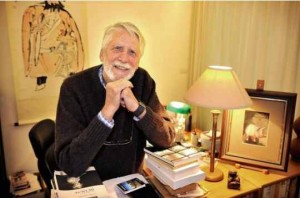Posted: August 17th, 2014 | No Comments »
A fascinating series of propaganda posters from the Sino-Japanese War….
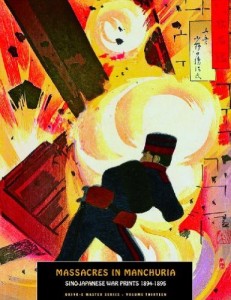
The first Sino-Japanese War of 1894-1895 was Japan’s first modern war, and their first military action overseas for over 300 years. One notable result of this conflict was a huge burst in popularity for senso-e (“war pictures”), a genre of ukiyo-e which first evolved as a contemporary mutation of musha-e (“warrior pictures”). The triptych, with its almost cinematic visual scope, was the preferred format for depicting such scenes of turmoil and carnage. Whilst quality ranges between artists, the very best senso-e remain amongst the finest in all of ukiyo-e.
Posted: August 16th, 2014 | No Comments »
RAS SHANGHAI BOOK CLUB
Monday, 19 August 2014 at 7 pm
Venue: RAS Library, Sino-British College
The RAS Book Club will meet to discuss:
The Blue Lotus
Series: Adventures of Tintin
Author: George Prosper Remi (Herg̩) РBelgian cartoonist
ISBN: 1-4052-0616-0
Publication Date: 1936 (black and white)
Publication Date: 1946 (color)
Staying at the palace of the Maharajah of Gaipajama in India, Tintin is approached by a visitor from Shanghai. Â The visitor supplies him with the name of Mitsuhirato, a Japanese businessman based in Shanghai, but before finishing his message is hit by a dart dipped in Rajaijah, the “poison of madness.”
Tintin and his fox terrier, Snowy, travel to Shanghai to meet Mitsuhirato, who warns them that the Maharajah is in danger and that they should return to India. Â Surviving several attempts on his life by mysterious assailants, Tintin attempts to leave for India by boat, but is kidnapped. Â His abductors reveal themselves as members of a secret society known as the Sons of the Dragon, who are devoted to combating the opium trade. Â Their spokesman, Wang Chen-Yee, explains to Tintin that Mitsuhirato is both a Japanese spy and an opium smuggler, and enlist him in their fight to stop him. Â Tintin agrees, and spies on Mitsuhirato at the Blue Lotus opium den. Â Following the spy, he discovers him blowing up a Chinese railway. Â The Japanese government uses this as an excuse to invade Northern China, taking Shanghai under its control.
Tintin is captured by Mitsuhirato, who plans to poison him with Rajaijah; however, a member of the Sons of the Dragon swaps the poison for colored water, and Tintin escapes unscathed. When Mitsuhirato discovers the deception, he convinces Dawson, the corrupt Chief of Police at the Shanghai International Settlement, to put a warrant out for Tintin’s arrest.
Meanwhile, Tintin enters the Settlement in search for Professor Fang Hsi-ying, an expert in poisons whom he hopes can develop a cure for Raijajah, but discovers that he has been kidnapped. Â Dawson’s police arrest Tintin and hand him over to the Japanese, who sentence him to death before he is rescued by Wang.
Traveling to Hukow with the ransom money for Fang, Tintin comes across a flood that has destroyed a village and rescues a young Chinese orphan, Chang Chong-chen. Â Chang accompanies Tintin to Hukow, where one of Mitsuhirato’s spies ambushes them; they realize that it was a trap and that Fang was not there.
Meanwhile, the detectives Thomson and Thompson are employed by Dawson to arrest Tintin, but fail on multiple occasions. Â Returning to Shanghai, Tintin intends to confront Mitsuhirato, and allows himself to be captured by him. Â Being held prisoner at The Blue Lotus, it is revealed that Mitsuhirato is working with the film director Roberto Rastapopoulos, who is the head of the international opium smuggling organization that Tintin had previously battled in Cigars of the Pharaoh. Â However, Tintin has formulated a plan, with Chang and the Sons of the Dragon appearing to rescue Tintin and Fang; Rastapopoulos is arrested while Mitsuhirato commits seppuku. Fang develops a cure for Rajaijah, while Wang adopts Chang as his son.
THE AUTHORÂ
Georges Prosper Rémi (22 May 1907 – 3 March 1983), known by the pen name Hergé, was a Belgian cartoonist.  His best known and most substantial work is the 23 completed comic books in The Adventures of Tintin series, which he made from 1929 until his death in 1983.  Also responsible for two other well-known series, Quick & Flupke (1930–1940) and Jo, Zette and Jocko (1936–1957), his works were executed in his distinct ligne claire drawing style.
Born to a lower-middle-class family in Etterbeek, Brussels, Hergé took a keen interest in Scouting, producing both illustrations and the Totor series for Scouting and Catholic magazines. In 1925 he started work for conservative newspaper Le XXe Siècle, where under the influence of Norbert Wallez, in 1929 he began serializing the first of his stories to feature boy reporter Tintin, Tintin in the Land of the Soviets.  Domestically successful, he continued with further Adventures of Tintin and the Quick & Flupke series at the paper, but from The Blue Lotus onward placed a far greater emphasis on background research.  After Le XXe Siècle was closed during the occupation by Nazi Germany, Hergé continued work for Le Soir.  After liberation, he faced accusations of being a collaborator, but was exonerated, and proceeded to oversee the creation of Tintin magazine, through which he remained artistic director over Studio Hergé until his death.
Hergé’s works have been widely acclaimed for their clarity of draughtsmanship and meticulous, well-researched plots, and have been the source of a wide range of adaptations.  He remains a strong influence on the comic book medium, particularly in Europe.  Since 2009, the Hergé Museum opened in Louvain-La-Neuve, honoring the world of Tintin and Hergé.
N.B. RESERVATIONS ESSENTIAL AS SPACE IS LIMITED AT THIS EVENT.Â
Posted: August 15th, 2014 | No Comments »
The magnificent Palais Garnier, the Paris Opera House was completed in 1875 and was Charles Garnier’s tour de force architecturally. Not everyone’s a fan of it – Le Courbusier hated it, but a confection such as the Palais Garnier has to contain a little Chinoiserie tucked away somewhere, surely? And so it does, in the Rotande du Glacier, a light and airy rotunda adorned with a painted ceiling by Georges Jules-Victor Clairin and tapestries illustrating a variety of drinks as well as hunting and fishing scenes. Completed after the Opera had opened. Among the drink related scenes on the walls is one of a Chinese lady pouring tea…
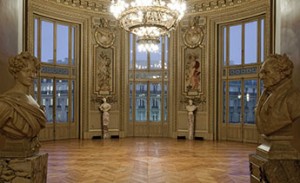
the Rotonde du Glacier
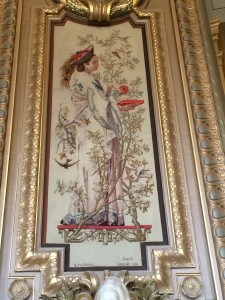
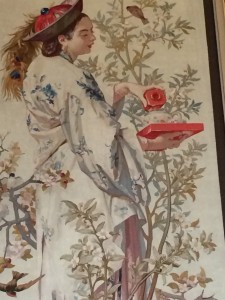
Posted: August 14th, 2014 | No Comments »

Lauren Bacall was always of course a captivating screen presence. In among the tributes to her this week surely room for a moment to remember her 1955 appearance as Cathy Grainger in Blood Alley. John Wayne is a merchant marine captain, rescued from the Chinese Communists by local villagers, only to be “shanghaied” into transporting the whole village to Hong Kong on an ancient paddle steamer.The film is an adaptation of Sidney Fleischman’s novel – Fleischman had been in the Pacific with the US Navy in WW2 and later wrote a number of novels set in the Far East. “Adventure on the danger waters of the Orient!” ran the tagline for the movie.
OK, so it was all filmed in California, large portions on Belvedere Island but still cost a cool US$2mn bucks (plenty gelt at the time). Bacall signed on to work with Robert Mitchum at first, but Mitchum pulled out, Gregory Peck turned it down and Bogart wanted too much money. Eventually Wayne took over the lead. There’s a fair bit of yellowface going on too. Bacall is a medical missionary’s daughter stranded in China after her father is killed by the commies. Sadly the film got a poor reception from the critics who found it a bit laboured despite its “exotic, Oriental setting.” Sadder still for China Rhymers perhaps, the infamous Blood Alley bar strip of Shanghai legend plays no role (the route by sea to Formosa is the Blood Alley of the title). Wayne and Bacall had little if any chemistry together. If you want a Hollywood ‘escape the Chi-commies by boat’ movie then you’re better of with the 1966 Sand Pebbles Steve McQueen movie quite honestly. But still Bacall, as ever, smoulders! You can check out the trailer here.

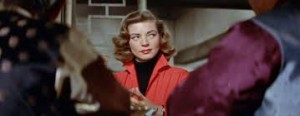



Posted: August 13th, 2014 | No Comments »
Clearing out the other day I came across a box of books from my early childhood – so basically the late ’60s and early ’70s. In amongst the books was Bengo’s Friends. Bengo the Boxer was the subject of a series of kid’s books published in the 1960s. I do not recall ever having learnt to read from Bengo’s Friends but I suppose I must have at some point…those wondering how exactly I came to be interested in China (subconsciously I suppose) may like to take a look at the rather distinctly politically incorrect last of Bengo’s many friends…
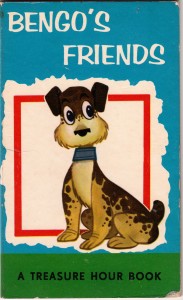
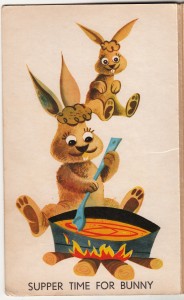
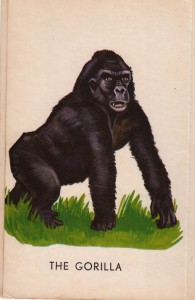
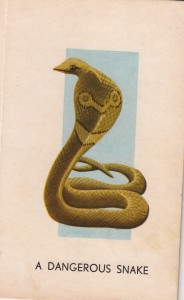
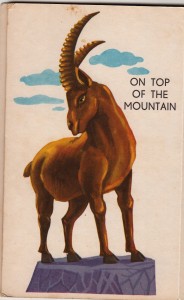
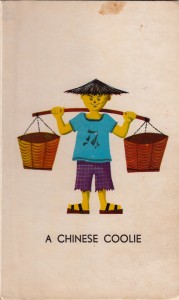
Posted: August 12th, 2014 | No Comments »
I love it when I come across a Chinese related reason that provides an excuse to show an image by a favourite artist who I might not otherwise have got to show on this blog. And so with Mark Gertler (British painter, avowed Londoner, East End Jew) and his 1908 oil on canvas painting Still Life with Melon, which won him a bronze medal in a Board of Education National Competition. This was an early painting, while Gertler was working at the stained glass company Clayton and Bell after having attended art classes at the Regent Street Polytechnic (and about the time he began attending the Slade). Now Gertler had no particular interest in China, or Chinoiserie or anything Oriental as far as I know, but in Still Life with Melon a blue and white China plate appears.
Where these random objects came from seems to be lost to history. However, Gertler often painted at his mum’s house in Spitalifields so maybe she had Chinese tastes or these were just items about the Slade in 1908.
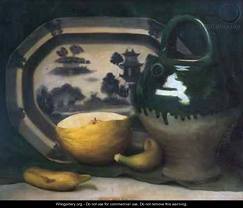
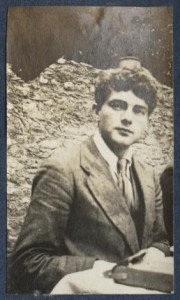
Posted: August 11th, 2014 | No Comments »
Quite by chance I recently came across a collection of essays, edited by Georgina Downey, entitled Domestic Interiors: Representing Homes from the Victorians to the Moderns. Contained within the collection is an enlightening essay by Brenda Martin called Verandas: Spaces Without Walls – the Veranda in Colonial Singapore. The essay is an interesting way to think of those verandas we’re all so familiar with in the literature and memoirs of the times (or even perhaps having had one yourself if you were lucky enough). The veranda as a public/private space, a place to demonstrate your social position, your adaptation to your foreign surroundings and your home culture. There’s a lot to consider in the humble veranda…..personally I like just standing on them watching a tropical rainstorm….
For me the veranda (just for the pedants – veranda is from the Portuguese varanda and the spelling with a h at the end is a variant according to the OED) in colonial Singapore and Malaya is always associated with Somerset Maugham – both Ethel Proudlock who left church in 1911 Kuala Lumpur, went home and shot her lover on her veranda (see Eric Lawlor’s excellent book on the case Murder on the Verandah) and Maugham’s novelization (or play to be precise) of the event, The Letter.

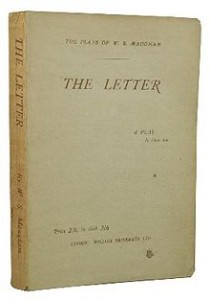 The Letter – first edition
The Letter – first edition
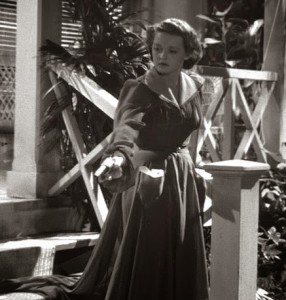 Bette Davis gets out on the veranda in The Letter (1940)
Bette Davis gets out on the veranda in The Letter (1940)



















